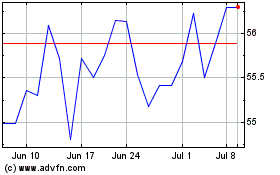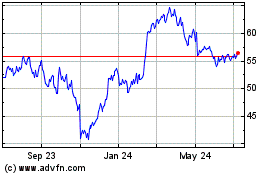Augmented Reality Gets Boost From Success of 'Poké mon Go'
July 13 2016 - 8:40AM
Dow Jones News
The sudden success of "Poké mon Go" is introducing consumers to
augmented reality, a technology that blends the digital and
physical worlds where many in Silicon Valley are placing big
bets.
Augmented reality displays digital images on a view of the real
world, such as Poké mon characters on a city sidewalk. "Poké mon
Go" shows digital characters on a smartphone screen, overlaid on
the phone's view of its surroundings.
Even before "Poké mon Go," many consumers tried a type of
augmented reality via Snapchat Inc.'s filters, which overlay masks
or dog noses onto users' faces in their smartphone screens as they
take snapshots of themselves.
Others are testing the technology. Microsoft Corp. is building
an augmented-reality headset called HoloLens. Google parent
Alphabet Inc.'s Project Tango adds sensors and software to
smartphones to make them better augmented-reality devices. Facebook
Inc. Chief Executive Mark Zuckerberg has said "immersive augmented
reality will become a part of daily life for billions of
people."
The success of "Poké mon Go"—it has been the most-downloaded
mobile app since its launch last week—is exciting other backers of
the technology.
"We love what they're doing. We think it is a gateway to the
whole new future we're building," Rony Abovitz, chief executive of
augmented-reality startup Magic Leap Inc., said at a Fortune
conference on Tuesday. Google and others have invested nearly $1.4
billion in Magic Leap, which has more than 600 employees building a
headset that projects images into users' eyes so the digital world
appears to interact with real life.
With Magic Leap's headset, "I would see Poké mon just like I see
real people—not looking through a screen," Mr. Abovitz said. "You
could have small Poké mon running around, hiding behind chairs…It
would be pretty epic."
Early versions of augmented reality, such as Google's Glass
headset, place a partly transparent screen in a user's field of
view. Smartphone versions of augmented reality show digital objects
in the phone's view of the real world. Several tech companies are
working toward head-worn devices that could display animations,
calendar reminders and emails alongside real objects, a more
advanced version of the technology many call mixed reality.
For those uses, the devices must understand the physical world
around them to seamlessly integrate the digital objects and provide
users with relevant information about their surroundings, such as
showing reviews when users look at a restaurant.
That next level of augmented reality faces major technical
hurdles. The technology requires multiple sensors and substantial
computing power to constantly interpret its surroundings. That has
made early versions of head-worn devices hot, heavy, inefficient
and expensive. Moreover, many people are reluctant to wear
computers on their faces.
Wider adoption of augmented reality may start with businesses.
Microsoft is working with Volvo AB to develop a virtual showroom
where prospective buyers can select features and colors of
prospective cars. Microsoft also is working with Trimble Navigation
Ltd. to feed 3-D building models into an application that
architects and engineers can view with a HoloLens, and developing a
version of its Skype video-messaging application to let co-workers
collaborate on product designs sharing holographic images. The
company envisions home-repair professionals helping
HoloLens-wearing homeowners remotely fix simple plumbing or wiring
problems.
Other startups, such as Atheer Inc. and Osterhout Design Group,
are selling augmented-reality headsets for use in health care or
engineering, such as overlaying a repair manual in workers' field
of view.
Microsoft this spring began selling a developer version of
HoloLens for $3,000 but it hasn't offered a timeline for a consumer
launch. Osterhout's headset sells for $2,750, Atheer's for
$4,000.
The craze around "Poké mon Go" also could spark more investment
in augmented reality, said Mike Rothenberg, whose firm Rothenberg
Ventures already has several such investments.
"It will move everyone forward a bit," Mr. Rothenberg said. He
compared the game's popularity to Facebook's 2014 acquisition of
Oculus VR Inc. for $2 billion, which triggered a wave of funding
for virtual-reality startups.
Other investors said the impact of the game may be more limited,
because it is tied to a well-known brand that appeals both to
children and to young adults who grew up with the characters.
First Round Capital Partner Chris Fralic pointed out that the
project is based on "world class" intellectual property. "I think
that is pretty unique," he said of the game's success.
Meta Co., a startup building an augmented-reality headset, is
selling a developer kit for $950 but isn't sure when it can release
a consumer version. Ryan Pamplin, the company's vice president of
partnerships, said "Poké mon Go" is "creating a lust for (augmented
reality) that hasn't existed outside some niches in the U.S."
Will the company accelerate its product's launch as a result? "I
don't know," he said. "Everyone's outside playing 'Poké mon
Go.'"
Write to Jack Nicas at jack.nicas@wsj.com, Cat Zakrzewski at
cat.zakrzewski@wsj.com and Jay Greene at Jay.Greene@wsj.com
(END) Dow Jones Newswires
July 13, 2016 08:25 ET (12:25 GMT)
Copyright (c) 2016 Dow Jones & Company, Inc.
Trimble (NASDAQ:TRMB)
Historical Stock Chart
From Mar 2024 to Apr 2024

Trimble (NASDAQ:TRMB)
Historical Stock Chart
From Apr 2023 to Apr 2024
